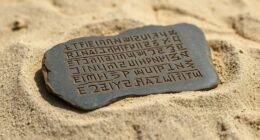Ground-penetrating radar has played a key role in revealing Oak Island’s Money Pit mysteries by detecting underground anomalies that could indicate hidden chambers or tunnels. This technology sends electromagnetic signals beneath the surface, helping you identify promising spots for excavation without disturbing the site’s delicate layers. While it doesn’t give all the answers by itself, it guides efforts efficiently. Keep exploring, and you’ll uncover more details about how modern science continues to chase the island’s legendary secrets.
Key Takeaways
- Ground-penetrating radar detects subsurface anomalies indicating possible hidden chambers or tunnels beneath Oak Island’s Money Pit.
- The technology provides non-invasive insights, helping target areas for excavation and reducing unnecessary digging.
- Anomalies identified by radar guide archaeologists to promising locations, increasing the chances of uncovering the treasure.
- While valuable, radar results alone do not confirm the presence of treasure or structures, requiring further investigation.
- Advances in radar technology continue to enhance the accuracy and effectiveness of Oak Island exploration efforts.

Have you ever wondered what mysteries lie beneath Oak Island? The legend of the legendary treasure buried deep within the island’s Money Pit has captivated explorers and treasure hunters for centuries. Despite numerous excavations and countless theories, the true nature of what’s hidden remains elusive. Today, modern archaeological methods, especially ground-penetrating radar, help us peek beneath the surface without disturbing the site’s delicate layers. This technology provides invaluable insights into what’s beneath the earth, guiding excavations with greater precision and less guesswork.
When you consider the legendary treasure, it’s easy to imagine a vast hoard of gold, jewels, or even ancient artifacts. But the truth is, no one really knows what’s down there. The Money Pit has been subjected to booby traps, false leads, and numerous failed attempts to uncover its secrets. Still, advances in archaeological methods allow researchers to scan the depths systematically, revealing anomalies that could indicate man-made structures or buried objects. This minimizes the risk of unnecessary digging and preserves the site’s integrity.
Using ground-penetrating radar, experts can send electromagnetic signals into the ground and analyze the reflected waves. These reflections can reveal voids, metal objects, or unusual formations that might suggest hidden chambers or tunnels. When you see these images, it’s as if the earth itself is whispering clues about what lies beneath. The radar scans don’t provide definitive answers but serve as a guide, helping investigators target promising areas for excavation. This approach increases efficiency and reduces the destructive nature of traditional digging, which can damage potential clues.
While the legendary treasure remains a mystery, applying archaeological methods like ground-penetrating radar keeps the search grounded in science and technology. It’s a way to respect the site’s history while pursuing answers more intelligently. Each scan brings us closer to understanding whether there’s a treasure buried deep within the Money Pit or if the legends are just that—stories passed down through generations. For you, as an observer or enthusiast, it offers a glimpse into how science and legend intertwine at Oak Island. The hope persists that someday, these modern techniques will uncover what’s truly hidden, resolving the centuries-old mystery once and for all. Until then, the legend of Oak Island continues to inspire curiosity, driven by the relentless pursuit of truth through archaeological innovation.
Recent advancements in archaeological methods like ground-penetrating radar help researchers analyze subsurface anomalies more effectively, offering new hope for uncovering the truth.
Frequently Asked Questions
Has Ground-Penetrating Radar Conclusively Proven Treasure Presence?
You might wonder if ground-penetrating radar has conclusively proven treasure presence. While it offers valuable insights, it doesn’t guarantee discovery. Metal detection and thorough historical analysis complement radar data, helping you assess potential findings more accurately. However, until definitive evidence emerges, radar alone can’t prove treasure exists. You should combine these methods, stay cautious, and continue exploring with an open mind, knowing that confirmation requires more than just radar results.
What Other Technologies Are Used Alongside Radar in Explorations?
You plunge into the depths of discovery, combining clever techniques like geophysical methods and remote sensing to explore hidden histories. Alongside radar, scientists use seismic surveys that shake the soil, magnetometers that measure magnetic anomalies, and resistivity imaging to detect subsurface features. These tools work together, weaving a web of wonder, helping you uncover secrets buried beneath the surface and revealing clues that might lead to treasure or truth.
How Deep Can Ground-Penetrating Radar Effectively Scan?
You might wonder how deep ground-penetrating radar can effectively scan. Typically, depth limitations depend on soil conditions and signal resolution; in ideal conditions, radar can reach depths of 30 to 50 feet. However, dense or moist soils reduce this capability, lowering the effective depth. The clearer the signals, the better your chances of detecting underground features, but soil interference often caps the maximum depth achievable.
Are There Legal Restrictions on Drilling or Digging at Oak Island?
You should know that legal restrictions often govern drilling or digging, especially at sensitive sites like Oak Island. Before you start any excavation, you need to secure proper permits, including drilling permits, from local authorities. These regulations aim to safeguard the site’s historical and environmental integrity, so skipping permits could lead to legal issues. Always check with relevant agencies to ensure your activities comply with all legal restrictions.
What Are the Main Theories About the Origin of the Money Pit?
You might wonder about the main theories behind the money pit’s origin. Some believe it has mythical origins, suggesting it’s part of legendary treasures or secret ancient caches. Others point to pirate legends, proposing pirates hid their loot there to protect it from authorities. These ideas fuel speculation, but without concrete evidence, the true story remains a mystery, keeping the fascination alive for treasure hunters and historians alike.
Conclusion
So, with ground-penetrating radar revealing secrets buried deeper than your wildest dreams, it’s clear Oak Island’s Money Pit isn’t just a simple hole in the ground—it’s the universe’s greatest treasure map! You almost expect pirates, curses, and ancient mysteries to jump out at you. Keep your eyes peeled, because someday, you might just stumble onto a fortune so big, it’ll make your head spin faster than the island’s legendary legends!









